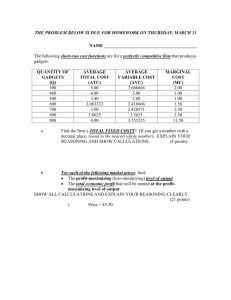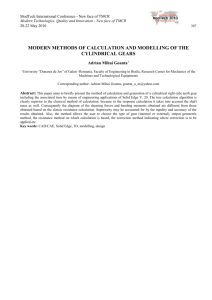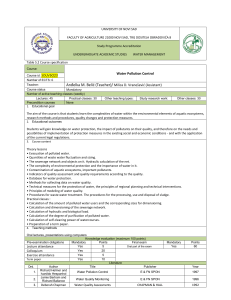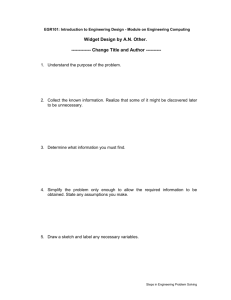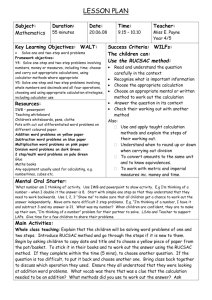flexibility in mental calculation in elementary students
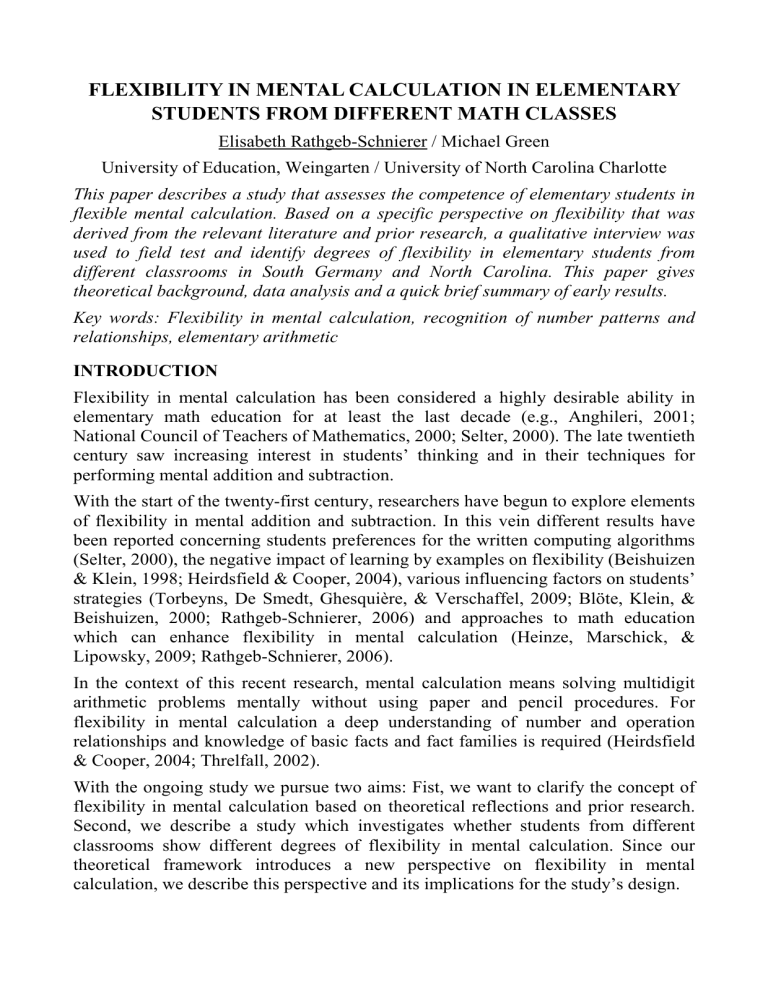
FLEXIBILITY IN MENTAL CALCULATION IN ELEMENTARY
STUDENTS FROM DIFFERENT MATH CLASSES
Elisabeth Rathgeb-Schnierer / Michael Green
University of Education, Weingarten / University of North Carolina Charlotte
This paper describes a study that assesses the competence of elementary students in flexible mental calculation. Based on a specific perspective on flexibility that was derived from the relevant literature and prior research, a qualitative interview was used to field test and identify degrees of flexibility in elementary students from different classrooms in South Germany and North Carolina. This paper gives
theoretical background, data analysis and a quick brief summary of early results.
Key words: Flexibility in mental calculation, recognition of number patterns and relationships, elementary arithmetic
INTRODUCTION
Flexibility in mental calculation has been considered a highly desirable ability in elementary math education for at least the last decade (e.g., Anghileri, 2001;
National Council of Teachers of Mathematics, 2000; Selter, 2000). The late twentieth century saw increasing interest in students’ thinking and in their techniques for performing mental addition and subtraction.
With the start of the twenty-first century, researchers have begun to explore elements of flexibility in mental addition and subtraction. In this vein different results have been reported concerning students preferences for the written computing algorithms
(Selter, 2000), the negative impact of learning by examples on flexibility (Beishuizen
& Klein, 1998; Heirdsfield & Cooper, 2004), various influencing factors on students’ strategies (Torbeyns, De Smedt, Ghesquière, & Verschaffel, 2009; Blöte, Klein, &
Beishuizen, 2000; Rathgeb-Schnierer, 2006) and approaches to math education which can enhance flexibility in mental calculation (Heinze, Marschick, &
Lipowsky, 2009; Rathgeb-Schnierer, 2006).
In the context of this recent research, mental calculation means solving multidigit arithmetic problems mentally without using paper and pencil procedures. For flexibility in mental calculation a deep understanding of number and operation relationships and knowledge of basic facts and fact families is required (Heirdsfield
& Cooper, 2004; Threlfall, 2002).
With the ongoing study we pursue two aims: Fist, we want to clarify the concept of flexibility in mental calculation based on theoretical reflections and prior research.
Second, we describe a study which investigates whether students from different classrooms show different degrees of flexibility in mental calculation. Since our theoretical framework introduces a new perspective on flexibility in mental calculation, we describe this perspective and its implications for the study’s design.
THEORETICAL FRAMEWORK
Process of calculation
Results of a previous study (Rathgeb-Schnierer, 2006; 2010), in which the development of strategies of mental calculation has been investigated, suggested that it is useful to examine the process of calculation in general, before focusing on flexible mental calculation. Based on this study the following model was developed to describe the process of calculation (Rathgeb-Schnierer, 2011): Solving problems is a complex interaction between different domains that implement different functions with different degrees of explication (Fig. 1).
Fig. 1: Domains of calculation process (Rathgeb-Schnierer, 2011)
In our work it has been necessary to consider three distinct but interrelated domains: methods of calculation, cognitive elements, and tools for solution. Each domain is a necessary but not sufficient condition for a calculation process. Taken together, the domains allow us to examine mental flexibility independent of a problem’s solution.
Each domain is described more fully below.
Methods of calculation: For solving any given problem, a student can use multiple methods of calculation such as the standard algorithm, partial sums, or mental
calculation (e.g., Selter, 2000). However, a method describes the way a solution process can be done but not how an answer is determined. For example, the standard algorithm describes a way an addition problem like 327 + 56 can be solved. First, the terms of the sum may be written correctly, one below the other to determine the sum of each column separately. This method doesn’t show the actual process for adding numbers. Looking at the example above, there are many possible tools for solution that could be used to find the answer for 6 joined with 7, like counting, drawing on basic facts, or using other adaptive strategic means. In short, obtaining a problem solution by itself does not shed light on the mechanism(s) used to achieve that solution.
Cognitive elements: Students’ solution processes are based on specific experiences that we designate with the term “cognitive elements”. Such cognitive elements that sustain a solution process can be learned procedures (such as computing algorithms), or they can be recognized number characteristics (such as number patterns and relationships) (Macintyre & Forrester, 2003; Threlfall, 2009). In reality, it is difficult
to reconstruct the basic cognitive elements that lie behind an exposed solution process as shown by Tanja, who solves the subtraction problem 46 – 19 (data from a prior project, Rathgeb-Schnierer, 2006):
Tanja: Um. 46 (.) minus (..) 9 – no, I do now minus 6 – and then, this equals 40 and then minus 3 equals – thirty-seven and then minus 10 equals 27.
Tanja exhibits a “Begin-With-One-Number-Method” (Fuson et al., 1997) by decomposing the subtrahend and subtracting it step by step. Whether her solution derives from a learned procedure, or from recognition and use of number patterns and relationships, or from a combination of the two cannot be determined from the information. However, for a correct assessment of Tanja’s abilities in mental calculation, it is crucial to know which cognitive elements her solution process entails. A procedure-based solution can be conducted mechanically, like following steps in a recipe, whereas a solution based on number characteristics entails dynamic use of knowledge of numbers and relationships.
Tools for solution: To find the answer to a problem, cognitive elements rely on additional tools that are used and combined in context. Specific tools for solution may be counting, referring to basic facts, or using other adaptive “strategic means”.
Our sense of these “strategic means” is that they are not holistic strategies or cognitive menus that complete a solution path; rather, they are distinct devices that can be combined in flexible ways to modify complex problems to make them easier.
Such strategic means include, for example, decomposing and composing
(65+28=60+20+5+5+3), transforming a problem (46-19=47-20), deriving the solution from a known problem (if 7 joined with 7 equals 14, the answer to 7 joined with 8 equals 15, since 8 is one more than 7), and using decade analogies (if 4 joined with 5 is 9, 40 joined with 50 must be 90) (Threlfall, 2002).
Whenever students solve a problem mentally, elements of all three domains are combined, and depending on that combination, one can identify different competencies. In judging mental flexibility, there is a meaningful difference between a student who mentally replicates a mechanically learned procedure and one who dynamically applies number sense, patterns, and problem characteristics to achieve a solution. This distinction is exemplified by the reasoning Simone shows with the subtraction problem 46-19:
Simone: If I do add one (points at the problem), then I have got 20 here and 47 there, and then it is easier to calculate.
Interviewer: Which problem do you solve then?
Simone: 47-20. This equals 26 (.) no 27.
Interviewer: And - are you sure that you get the same answer to 47-20 and 46-19?
Simone: Yes, because I have added one to both numbers, and then I have more here
(points to 47) and take away more there (points to 20).
Obviously Simone has solved the problem by mental calculation. First, she has transformed the actual problem into a new one that preserves the difference between the numbers. For Simone, the transformed problem is almost trivial. Her solution relies on a combination of subtraction basic facts and her knowledge of decade analogies. Simone has recognized the numerical proximity of 19 to 20, and she adapted this knowledge to the situation by transforming the problem. What we describe in the case of Simone is called “zeroing in” by Threlfall (2009, 47).
Flexibility in mental calculation
Multiple, inconsistent perspectives on the concept flexibility in mental calculation exist in the literature (Star & Newton, 2009). Depending on the definition used, different ways of operationalization are implied.
We choose to navigate through this somewhat confusing terrain by […] defining flexibility as knowledge of multiple solutions as well as the ability and tendency to selectively choose the most appropriate ones for a given problem and a particular problem-solving goal (Star & Newton 2009, 558).
In the present article, we will, henceforth, use the dual term ‘flexibility/adaptivity’ as the overall term, ‘flexibility’ for the use of multiple strategies, and ‘adaptivity’ for making appropriate strategy choices (Verschaffel, Luwel, Torbeyns, & Van Dooren, 2009,
337/338).
First […] we employed the definition of strategy flexibility as choosing among different strategies simply on the basis of the characteristics of the task, i.e. as using the compensation strategy on problems with a unit digit 8 or 9. Second, we also applied a more sophisticated definition wherein strategy flexibility is conceived as selecting the strategy that brings the child most quickly to an accurate answer to the problem (Torbeyns et al., 2009, 583).
All these definitions have in common the idea that flexibility in mental calculation is connected – explicit or implicit – with adaption and means an appropriate way of acting when faced with a problem. What exactly is meant by appropriate and how an appropriate way of acting can be identified is considered differently (Rechtsteiner-
Merz in prep.). There is, on the one hand, the notion of choice in selecting an appropriate solution to a given problem (and perhaps including the choice of a solution deemed most appropriate). On the other hand, the appropriate way of acting when faced with a problem may not be determined by task characteristics but by the speed of obtaining a solution. In both views the focus is on mental outcomes, since researchers have typically regarded only one domain of the calculation process (Fig.
1), the tools for solution.
Similar to Threlfall (2002, 2009) and prior research (Rathgeb-Schnierer, 2006, 2010) we also define flexibility in mental calculation as a way of acting appropriately, but we have a different conception of what is meant by appropriate. Rather than the choice of the most suitable strategy or the quickest way of obtaining a solution,
appropriate acting for us means to match the combination of strategic means (see above) to the recognized number patterns and relationships of a given problem in the context of processing a problem solution. The recognition of problem characteristics, number patterns and relationships, and their use for solving a problem again depends on a student’s knowledge of numbers and operations or what Threlfall (2002, 29) terms an “interaction between noticing and knowledge”:
When faced with a fresh problem, the child or adult who follows different solution paths depending on the numbers does not do so by thinking about what the alternatives are and trying to decide which one to do. Rather, he or she thinks about the numbers in the problem, noticing their characteristics and what numbers they are close to, and considering possibilities for partitioning or rounding them. (Threlfall 2002, 41)
Our discussion leads us to posit a new perspective on flexible mental calculation because we are interested in mental processes that underlie the outcomes. That means, related to the model of process of calculation (Fig. 1), we focus on two different domains to identify the degree of flexibility in students: the tools for solution and the cognitive elements that support the solution processes. Only if the tools of solution are linked in a dynamic way to problem characteristics, number patterns, and relationships would we consider as evidence of flexibility in mental calculation. Hence our central questions about mental flexibility are: What problem characteristics, number patterns, and relationship do students recognize? And how do they use problem characteristics, number patterns, and relationships to solve problems?
OVERVIEW ON THE PROJECT
Questions and Assumptions
We investigated flexible mental calculation in elementary students from different classrooms in different countries. Referring to earlier research and our perspective on flexibility, the project is based on fundamental assumptions: First, there are different features in students’ ways of acting when faced with an addition or subtraction problem that can be considered as indicators of flexibility. One feature is the recognition of problem characteristics, number patterns, and relationships in a given problem, and the other one is the dynamic use of recognized number patterns and relationships for solving a problem. Second, flexibility in calculation is not an all-ornone-phenomenon; it occurs in varying degrees (Rathgeb-Schnierer, 2010).
Research questions concerning the sorting task as research instrument: Does sorting problem cards into categories “easy” or “hard” help initiate mental flexibility when it is available? Do differences appear regarding sorting and reasoning, and can they be linked to different degrees of flexibility?
Research questions concerning patterns that appear in sorting, reasoning, and
solving problems: Do students describe reasoning about problem characteristics,
number patterns, and relationships? Do students link their tools for solution to recognized problem characteristics, number patterns, and relationships? Can different degrees of flexibility be identified and pooled into general types?
Research questions concerning different classrooms: Do differences and tendencies show up in sorting, reasoning, and using tools for solution for students from different math classrooms? Do differences appear regarding sorting and reasoning, and can they be linked to different degrees of flexibility?
Design
Based on the theoretical model of flexibility introduced earlier, a qualitative study has been designed and carried out. Since we were interested in mental processes underlying the process of solving a problem, we decided on probing interviews as a research instrument (see following paragraph). Second graders and fourth graders from different instructional contexts in Germany (Baden-Württemberg) and USA
(Charlotte, North Carolina) were selected. In total ten classrooms, 3 second grades and 2 fourth grades in each country, were sampled. We chose about eight students form each classroom. Students with learning disabilities in math or with language problems were excluded in order to achieve a minimal level of understanding of number and operation. Based on the judgment of the classroom teacher, we got a sample representing predominantly middle and high achievers and carried out interviews with a total 51 second graders and 31 fourth graders.
Interviews
We developed a qualitative, problem-oriented interview that contains twelve twodigit addition and subtraction problems. Each problem was designed to show at least one special feature, sometimes more than one. Our problems incorporated features like double and half relations, same numbers at the tens and ones place, one number close to ten, both numbers close together, numbers at the ones place equal ten, reverse problems, and problems that require regrouping. These problems were displayed on small cards: 33+33, 66-33, 56+29, 46-19, 31-29, 73+26, 88-34, 34+36,
65+35, 95-15, 47+28 and 63-25.
Interviews had three parts, the first for sorting problems and talking about the sorting procedure, the second for solving problems, and the third for comparing selected problems. In the first step, cards were mixed and laid out on the table. Students were encouraged to look carefully at the numbers in each problem and sort the problems in two categories, “easy” and “hard” (these labels were placed at each side of the table).
After a card was placed either to the “hard” or the “easy” side (occasionally students decided on the middle), we asked: “Why is this problem easy or hard for you?” In the second step we asked the students to choose some problems from each side and to tell us what they were thinking when they solved the problem. We always started with the easy side and skipped all the problems that had already been solved during the sorting process. In the third step we focused on selected problems (63-25 and 88-
34; 47+28 and 73+26) and encouraged students to compare these in order to estimate whether one of each pair might be easier.
Students were interviewed one-on-one for 15 to 30 minutes. Video and audio recording was done for the whole interview.
Interviews were conducted by one researcher and took part in the last two months of the academic year (Germany 2010 and 2012, USA 2011). All interviews were transcribed in their original language for data analysis.
Data Analysis
Two coding systems that include both a priori and inductive meanings were used.
One system was used to classify students’ tools for solution; the other one was used to catalog reasoning for easy and hard problems.
The following example illustrates how a part of the coding system was developed.
Data suggested that reasoning could be divided in four core categories (first level): reasoning by problem characteristics – easy (A/1), reasoning by problem characteristics – hard (A/2), reasoning by ways of solution – easy (B/1) and reasoning by ways of solution – hard (B/2).
Two different students explained why 33+33 is an easy problem:
S 1: Because there's the same numbers in each 'um space. (A/1)
S 2: Because first I add 30 and 3, and then I add 3. (B/1)
To each core category we developed codes (second level) based on possible characteristics of numbers (e.g., Fig. 2) and theoretically described solution strategies (e.g., Selter, 2000; Threlfall, 2002). The sub-codes (third level) arose from the data again. All together we got three levels of categories/codes that were invented by combining data-based and theory-based methods. With this differentiated coding system students’ utterances can be exactly assigned. See student 1 in the example above: His utterance is assigned on the first level to the core category “reasoning by characteristics – easy,” on the second level to the code
“special numbers”, and on the third level to the sub-code “double digits”.
First results and outlook on further data analyses
At the moment we have transcribed 70 interviews and categorized one third of the data using both coding systems. While we cannot yet provide definite answers to our research questions, we can report on some initial patterns we have observed. We illustrate these patterns based on a sample of 21 second grade students from three
German classrooms.
interrelating two feature spaces: the way of reasoning and the tools for solution.
Therefore, we use a two-dimensional space with ways of reasoning (from one exhibited way, to various ways) plotted on one axis and tools for solution (from one exhibited tool to various tools) plotted on the other axis. Depending on characteristic patterns students display in reasoning and solving, we will assign each student to a special point in the two-dimensional space and pool those who exhibit the same patterns of features. In a last step of analysis we plan on linking the types we have found to the teachers’ math instruction and dispositions to see if students’ math experiences are associated with degrees of flexibility.
REFERENCES
Anghileri, J. (2001). Intuitive Approaches, Mental Strategies and Standard
Algorithms. In J. Anghileri (Ed.), Principles and Practices in Arithmetic
Teaching: Innovative approaches for the primary classroom (79-94). Suffolk: St
Edmundsbury Press.
Beishuizen, M., & Klein, A. S. (1998). The empty number line in Dutch second grades: Realistic versus gradual program design. Journal for Research in
Mathematics Education, 29(4), 443-464.
Blöte, A.W., Klein, A.S., & Beishuizen, M. (2000). Mental computation and conceptual understanding. Learning and Instruction, 10(3), 221-247.
Fuson, K.C., Wearne, D., Hiebert, J.C., Murray, H.G., Human, P.G., Oliver, A.I.,
Carpenter, T.P., & Fennema, E. (1997). Children’s Conceptual Structures for
Multidigit Numbers and Methods of Multidigit Addition and Subtraction. Journal
for Research in Mathematics Education, 28(2), 130-162.
Heinze, A., Marschick, F., & Lipowsky, F. (2009). Addition and subtraction of threedigit numbers: adaptive strategy use and the influence of instruction in German third grade. ZDM - The International Journal on Mathematics Education, 41(5),
591-604.
Heirdsfield, A.M., & Cooper, T.J. (2004). Factors affecting the process of proficient mental addition and subtraction: case studies of flexible and inflexible computers.
Journal of Mathematical Behavior, 23(4), 443-463.
Kelle, U., & Kluge, S. (2010). Vom Einzelfall zum Typus: Fallvergleich und
Fallkontrastierung in der qualitativen Sozialforschung [From singel case to type:
Comparing and contrasting in qualitative social research]. Wiesbaden: Verlag für
Sozialwissenschaften.
Macintyre, T., & Forrester, R. (2003). Strategies for mental calculation. In J.
Williams (Ed.), Proceedings of the British Society for Research into Learning
Mathematics, 23(2), 49-54.
National Council of Teachers of Mathematics (NCTM) (2000). Principles and
standards for school mathematics. Reston, VA: NCTM.
Rathgeb-Schnierer, E. (2006). Kinder auf dem Weg zum flexiblen Rechnen: Eine
Untersuchung zur Entwicklung von Rechenwegen von Grundschulkindern auf der
Grundlage offener Lernangebote und eigenständiger Lösungsansätze [Study on students‘ flexibility in mental calculation based on an open approach].
Hildesheim; Berlin: Franzbecker.
Rathgeb-Schnierer, E. (2010). Entwicklung flexibler Rechenkompetenzen bei Grundschulkindern des 2. Schuljahrs [The development of flexible mental calculations of second graders]. Journal für Mathematik-Didaktik, 31(2), 257-283.
Rathgeb-Schnierer, E. (2011). Warum noch rechnen, wenn ich die Lösung sehen kann? Hintergründe zur Förderung flexibler Rechenkompetenzen [Why counting when I see the solution? Theoretical framework of teaching flexible mental calculation]. In R. Haug & L. Holzäpfel (Eds.), Beiträge zum
Mathematikunterricht 2011 (15-22). Münster: WTM-Verlag.
Rechtsteiner-Merz, Ch. (in prep.). Flexibles Rechnen und Zahlenblickschulung – eine
Untersuchung zur Entwicklung von Rechenkompetenzen bei Erstklässlern, die
Schwierigkeiten beim Rechnenlernen zeigen [Flexible calculation and number sense. Study on numeracy skills of 1 st
graders with disabilities in learning math]
(Unpublished doctoral dissertation). Pädagogische Hochschule, Weingarten.
Selter, C. (2000). Vorgehensweise von Grundschüler(inne)n bei Aufgaben zur
Addition und Subtraktion im Zahlenraum bis 1000 [Strategies of primary students in addition and subtraction of three-digit numbers]. Journal für Mathematik-
Didaktik, 21(3/4), 227–258.
Star, J.R., & Newton, K.J. (2009). The nature and development of experts’strategy flexibility for solving equations. ZDM - The International Journal on Mathematics
Education, 41(5), 557-567.
Threlfall, J. (2002). Flexible mental calculation. Educational Studies in Mathematics,
50(1), 29-47.
Threlfall, J. (2009). Strategies and flexibility in mental calculation. ZDM - The
International Journal on Mathematics Education, 41(5), 541-555.
Torbeyns, J., De Smedt, B., Ghesquière, P., & Verschaffel, L. (2009). Jump or compensate? Strategy flexibility in the number domain up to 100. ZDM - The
International Journal on Mathematics Education, 41(5), 581-590.
Verschaffel, L., Luwel, K., Torbeyns, J., & Van Dooren, W. (2009).
Conceptualizing, investigating, and enhancing adaptive expertise in elementary mathematics education. European Journal of Psychology of Education, 24(3),
335-359.

